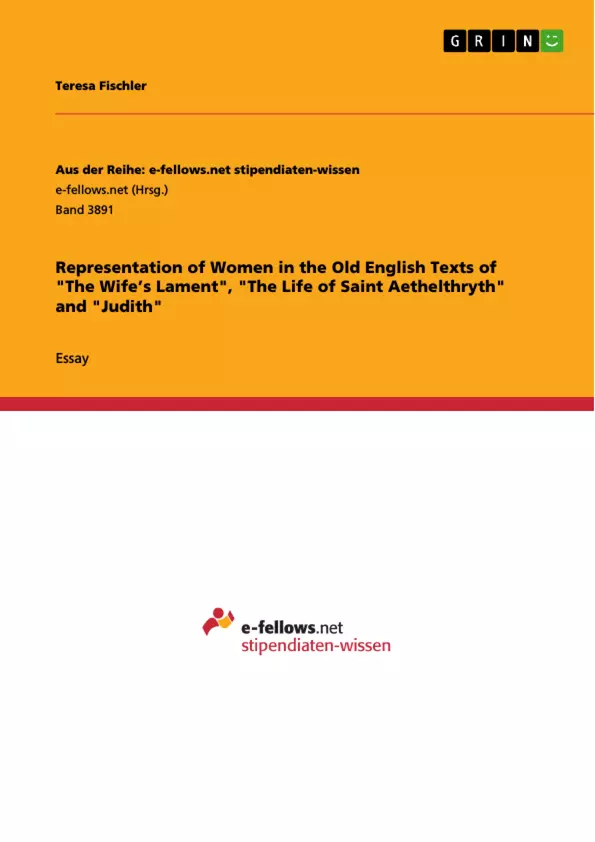This essay discusses the representation of women in the texts "The Wife’s Lament", "The Life of Saint Aethelthryth" and "Judith". It examines if and how these women are given voices and subjectivity. Literature from Anglo-Saxon times provides us with a picture of heroic battles, brave lords and warriors, bishops and martyrs. However, in the background of all the noble men and their deeds, there is another crucial part of this society which is often left out: women. Few texts from that time actually present a woman as the main character or even mention a woman, which already tells us a lot about womanhood at that time. It seems like it was percieved as something not worth writing about. While considering that, the works that actually do feature women provide interesting insights about the meaning of femininity and being a women in Anglo-Saxon times, while all depict women in a different way.
Inhaltsverzeichnis (Table of Contents)
- Restrained or Underestimated?
- The Wife's Lament
- The Life of Saint Æthelthryth
- Judith
Zielsetzung und Themenschwerpunkte (Objectives and Key Themes)
This text aims to analyze the representation of women in Old English literature and assess if and how these women are given voices and subjectivity. It examines three distinct texts: The Wife's Lament, The Life of Saint Æthelthryth, and Judith, focusing on the portrayal of femininity within each work.
- The portrayal of women in Old English literature
- The presence and nature of female voices and subjectivity
- The impact of social and cultural norms on women's lives
- The use of language and genre to convey female perspectives
- The exploration of feminine strength and resilience
Zusammenfassung der Kapitel (Chapter Summaries)
- The Wife's Lament: This chapter focuses on the elegiac poem The Wife's Lament, examining the narrator's expressions of sadness over the loss of her husband. The chapter analyzes the narrator's seemingly passive behavior and lack of agency, exploring arguments for and against her subjectivity. The chapter delves into linguistic indicators, such as the frequent use of the first-person pronoun "I" and the interpretation of key words like "hatan" and "niman," to uncover possible signs of the narrator's voice and self-awareness.
- The Life of Saint Æthelthryth: This chapter explores the short biography of Saint Æthelthryth, focusing on the portrayal of her life as determined by patriarchal decisions and societal rules. The chapter analyzes the use of passive voice in the text, highlighting the potentially submissive nature of Æthelthryth's actions. However, it also examines elements suggesting Æthelthryth's own agency, including her refusal of sexual intercourse and her persistent efforts to pursue her desires. The chapter discusses the significance of Æthelthryth's inheritance of land and its role in providing her with a degree of power and control.
- Judith: This chapter examines the Old Testament story of Judith, focusing on the character's martial, masculine, and feminine characteristics. The chapter analyzes the potential for Judith's portrayal as a testament to the ideal of monastic enclosure and the idea that her strong features might be overshadowed by the societal pressure for female purity. It further analyzes the arguments for Judith's subjectivity, highlighting her agency in planning and executing her actions, her commanding language, and the respect she receives within her community. The chapter discusses the significance of Judith's feminine attributes in facilitating her success.
Schlüsselwörter (Keywords)
This text focuses on the representation of women in Old English literature, exploring themes of femininity, voice, subjectivity, agency, social and cultural norms, language, and genre. It examines specific texts such as The Wife's Lament, The Life of Saint Æthelthryth, and Judith, analyzing their portrayal of female characters within the context of Anglo-Saxon society. Key terms include "heroic femininity," "monastic enclosure," "passive behavior," "linguistic indicators," "subjectivity," "patriarchal decisions," and "female agency." The text also explores the role of religious and societal expectations in shaping the representation of women in Old English literature.
- Quote paper
- Teresa Fischler (Author), 2019, Representation of Women in the Old English Texts of "The Wife’s Lament", "The Life of Saint Aethelthryth" and "Judith", Munich, GRIN Verlag, https://www.grin.com/document/1119580



